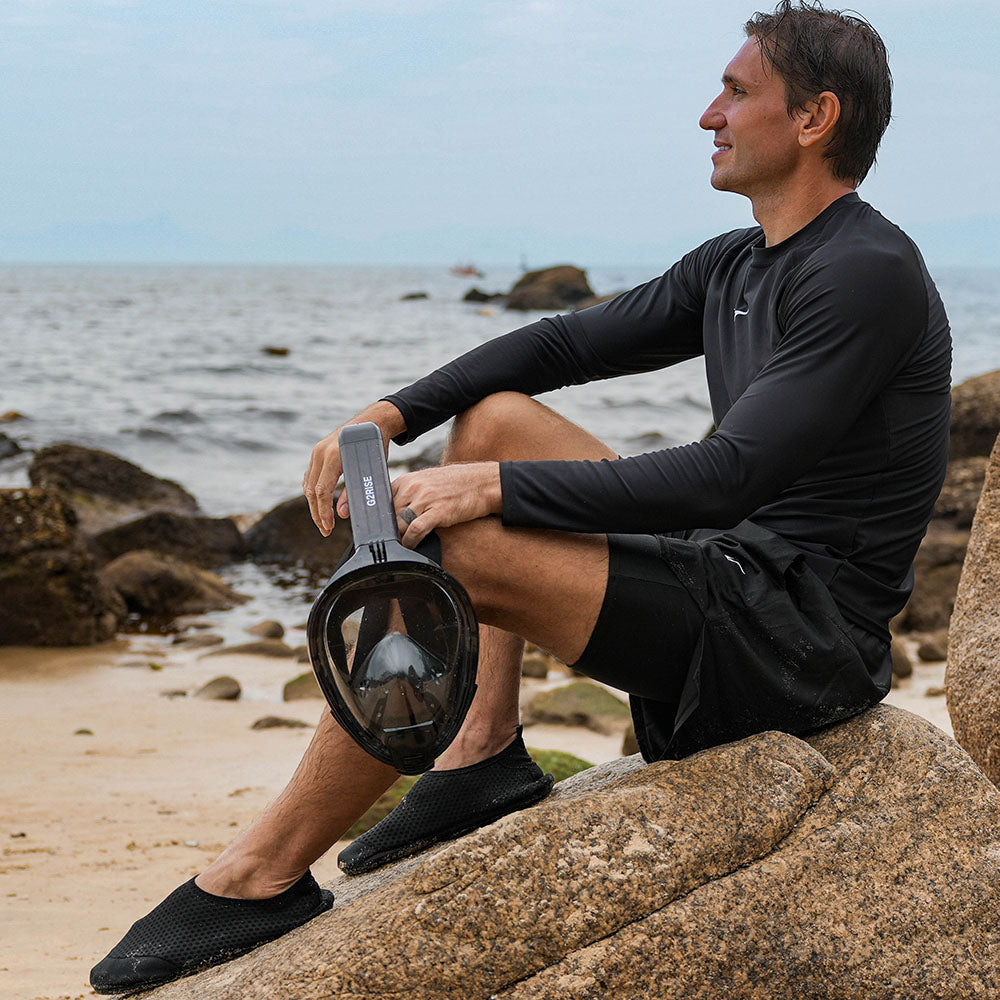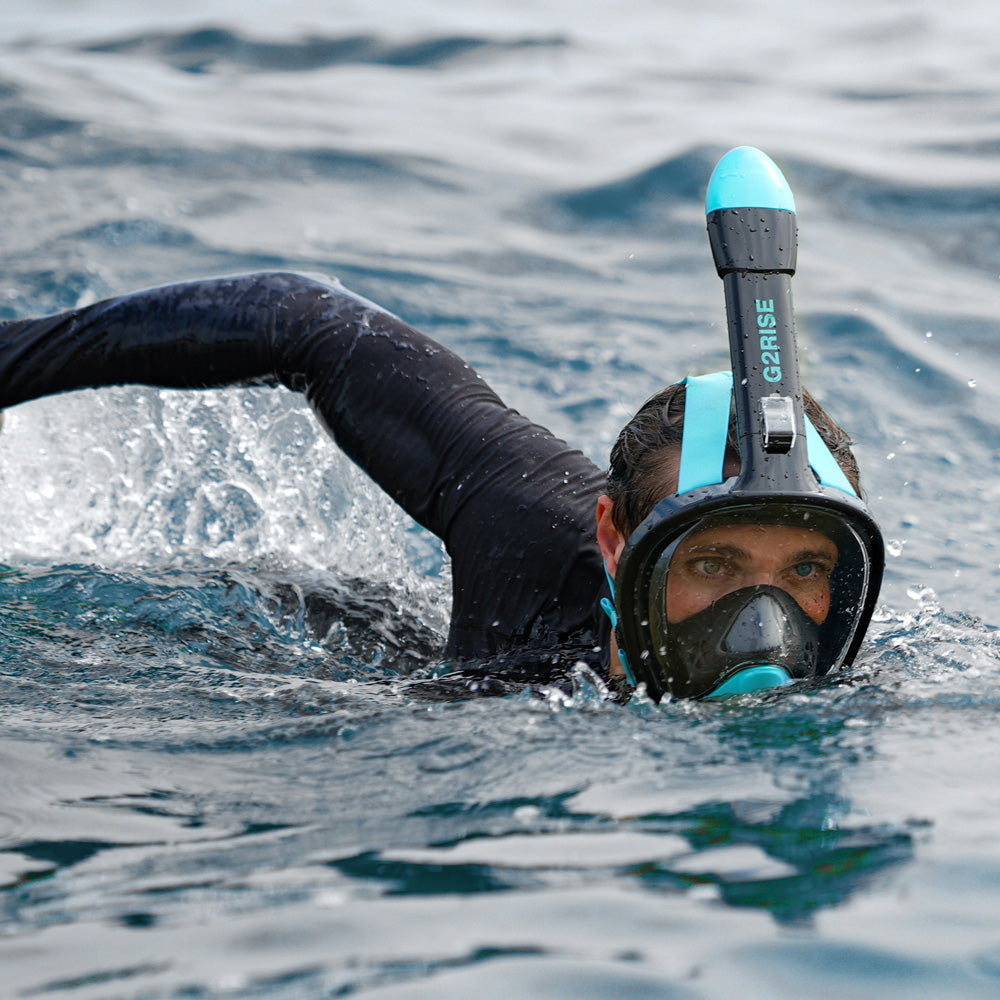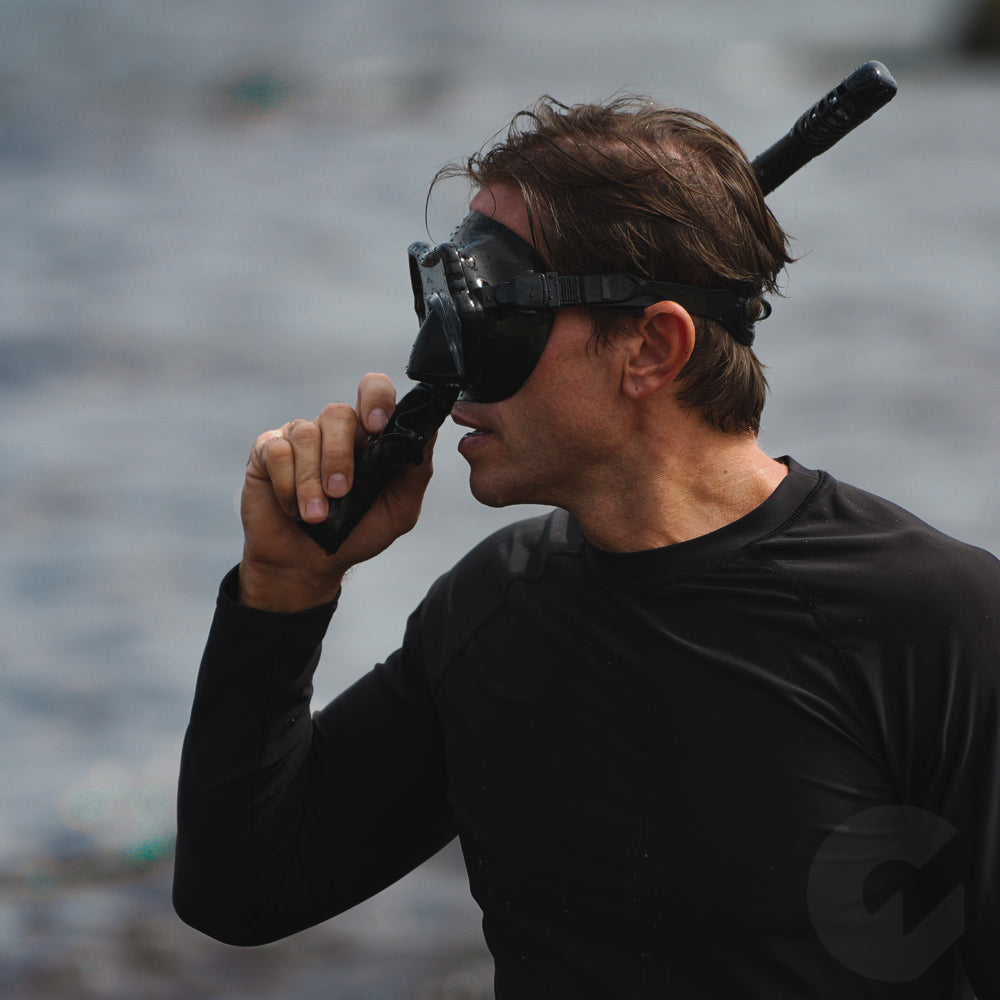Foggy snorkel masks can ruin an underwater adventure. When your view is blocked, you miss out on colorful fish, coral reefs, and other marine wonders. More importantly, a clouded mask can be dangerous, making it hard to spot obstacles or stay aware of your surroundings. This problem affects both novice and experienced snorkelers alike. Fortunately, there are effective ways to prevent and deal with mask fogging. This guide covers everything from quick fixes to long-term solutions, helping you maintain a clear view throughout your snorkeling trips.

Why Snorkel Masks Fog Up
Fogging is a common problem that can spoil your snorkeling experience. To effectively prevent it, it's crucial to know what causes this issue.
The Main Cause: Temperature Difference
Fogging occurs when the warm air inside your snorkel mask meets the cool lens. Your breath and face heat the air in the mask, while the water cools the lens. This temperature gap causes water vapor to condense on the lens, creating fog.
Other Factors That Increase Fogging
- Residues on New Masks: New masks often have manufacturing residues that attract water droplets.
- Skin Oils and Lens Damage: Oils from your skin and small scratches on the lens provide spots for fog to form.
- Dirt and Contaminants: Sunscreen, salt, or other debris on the lens increase fogging.
- Poor Cleaning: A dirty mask fogs up more easily than a clean one.
These factors create more surfaces for water droplets to stick to, worsening the fogging problem.
How to Get Your New Snorkel Mask Ready
A new snorkel mask needs proper preparation before its first use. These methods will help you achieve the best clarity and extend your mask's lifespan.
The Toothpaste Trick
Many experienced divers use toothpaste to clean new masks. Start by applying a small amount of non-abrasive toothpaste to the inside of the lens. Gently rub it in circles, covering the whole surface. Let it sit for about 15 minutes, then rinse thoroughly with cool water. This simple process removes invisible manufacturing residues that often cause fogging.
Dealing with Tough Coatings
Some masks have stubborn protective layers that resist normal cleaning. For these, try using heat. Carefully warm the lens with a hairdryer on its lowest setting. As it warms up, use a plastic card to gently scrape off any visible coating. Wipe it clean with a soft cloth, then follow up with the toothpaste method for best results. Be careful not to overheat the mask, as this could damage the silicone parts.
Keeping Your Mask Clear
Regular care keeps your mask fog-free and in good shape. Before each dive, give your mask a quick rinse with fresh water to remove dust or debris. Then, apply a thin layer of anti-fog solution or baby shampoo to the inside of the lens. Spread it evenly with your fingers and rinse lightly. This creates a protective film that helps prevent fogging.
Maintenance Tips to Prevent Snorkel Mask Fogging
Proper maintenance of the snorkel mask will make the difference between good and excellent below-water visibility. Here are some simple, yet effective, maintenance techniques that will help your mask be free of fog and last longer.
1. Clean Your Mask After Every Use
After snorkeling, be sure to very thoroughly rinse your mask with fresh water. Pay close attention to the lens, frame, and strap. This is to remove any residual salt, sand, or other particles that might precipitate fogging. Gently rub away stubborn debris with your fingers.
2. Do a Deep Clean Monthly
Clean your mask with mild, unscented soap and warm water once a month. Gently scrub all surfaces, paying special attention to hard-to-reach areas. Then, rinse well to take away all soap residue. This deep clean removes build-up that regular rinsing may miss.
3. Dry Your Mask Properly
Shake off excess water after cleaning. Let your mask air dry in a well-ventilated area, out of direct sunlight. Allow it to be completely dry before storage to prevent mold buildup. You can keep it in a mesh bag while storing for good ventilation.
4. Apply Anti-Fog Solution Before Use
Apply a thin layer of anti-fog solution or baby shampoo to the inside of the lens before each dive. Rub evenly with fingers, then lightly rinse in order to leave a thin film on them that may help prevent fogging.
5. Ensure a Proper Fit
Put on the mask while your face is dry. Place it on your face and press it lightly to secure the seal by inhaling a bit through your nose. A better-fitting mask does not let water in that easily, causing fogging.
6. Avoid Frequent Mask Removal
Once in the water, try to stay with your mask on. Taking it off too much lets water seep in and hence fog it up. If you have to adjust it, lean your head back slightly as you reseat the mask to help keep water out.
Effective Defogging Solutions for Snorkel Masks
This does not preclude it from fogging, however. Because of this, there are a number of means by which the problem of fog is combated both quickly and efficiently. These range from commercial products to natural alternatives, options for every preference and situation that may arise.
1. Commercial Anti-Fog Agents
Many divers rely on and use off-the-shelf anti-fog sprays or gels. These are usually made to serve the purpose of mask defogging, with many times a long-lasting effect. However, some may contain chemicals in them that can irritate sensitive skin or eyes. Always test small before rinsing thoroughly for use.
2. Baby Shampoo: A Gentle Alternative
Baby shampoo is a popular, eco-friendly defogging option. Mix one drop with water, apply inside the lens, and rinse very lightly. It has a mild formula so is less likely to irritate and is biodegradable hence environmentally friendly.
3. Emergency Defogging with Saliva
Saliva works as an emergency fog remover-just a hint of saliva does wonders with fighting the fog. Not exactly the cleanliest thing to do, but you can resort to it for those unexpected fog problems. Just spit inside of your mask and smear it on the lens. Then, if desired, lightly rinse. Just do this rarely, and make sure you clean your mask afterwards well.
4. Home Remedies
A number of household items serve to defog. Glycerin and water solution produces a long-lasting anti-fogging effect. Mild dish soap works in just the same way when in very low concentration-like baby shampoo. Some divers know the secret of potato juice-just rub a slice of raw potato on the lens and rinse.
5. Investing in Anti-Fog Masks
For a more permanent solution, consider purchasing a mask with anti-fog technology built right in. Most of them make use of various coatings or designs that vastly cut down on fogging. For instance, the G2rise SN01 is a notable option, featuring an enhanced system with a larger breathing chamber and dual intake valves for improved airflow. Its design separates inhalation and exhalation channels, reducing CO2 buildup and promoting extended fog-free performance.
Special Considerations for Snorkel Mask Fogging
Even with proper care, some masks have their quirks when it comes to fogging. Knowing such special cases will also help you in solving those nagging problems.
When DIY Methods Fail
If your mask continues to fog despite trying various solutions, then this might be the time for professional intervention. Yes, dive shops do offer specialized cleaning services that may solve the insurmountable problems. Professionals use advanced techniques and products to remove built-up residues or restore damaged coatings.
Consider a professional service if:
- Your mask fogs consistently despite regular cleaning and anti-fog treatments
- There's a visible film on the lens that won't come off with normal cleaning
- The mask is old and has never been professionally serviced

Full Face Mask Fogging Issues
Full face snorkeling masks are a special case because of their design. With the full face snorkeling masks, the whole of your face is covered, and there is division between the chambers for viewing and breathing, hence giving different fogging patterns.
To prevent fogging in full face masks:
- Ensure a proper fit - the mask should create a complete seal around your face
- Clean the mask thoroughly after each use, paying extra attention to the breathing valve
- Apply anti-fog solution carefully, avoiding the breathing mechanism
- Consider models with advanced ventilation systems designed to reduce fogging
If you are a beginner in this kind of full-face mask, ask for other divers' advice or dive shop personnel about some methods you use for care and usage.
Get the Most Out of Your Snorkeling Trip!
Keep your mask clean, use anti-fog products, and be careful about quick temperature changes. With these simple steps, you will be able to see well underwater. You will see the fish and other sea life much better when you have a clear mask. You will be in a safer position, too, as you can clearly see any obstacles in your way. Whether one is using a full-face mask or an ordinary mask, following are a few tips which make snorkeling a lot more fun. Have fun exploring the underwater world!











Leave a comment
This site is protected by hCaptcha and the hCaptcha Privacy Policy and Terms of Service apply.